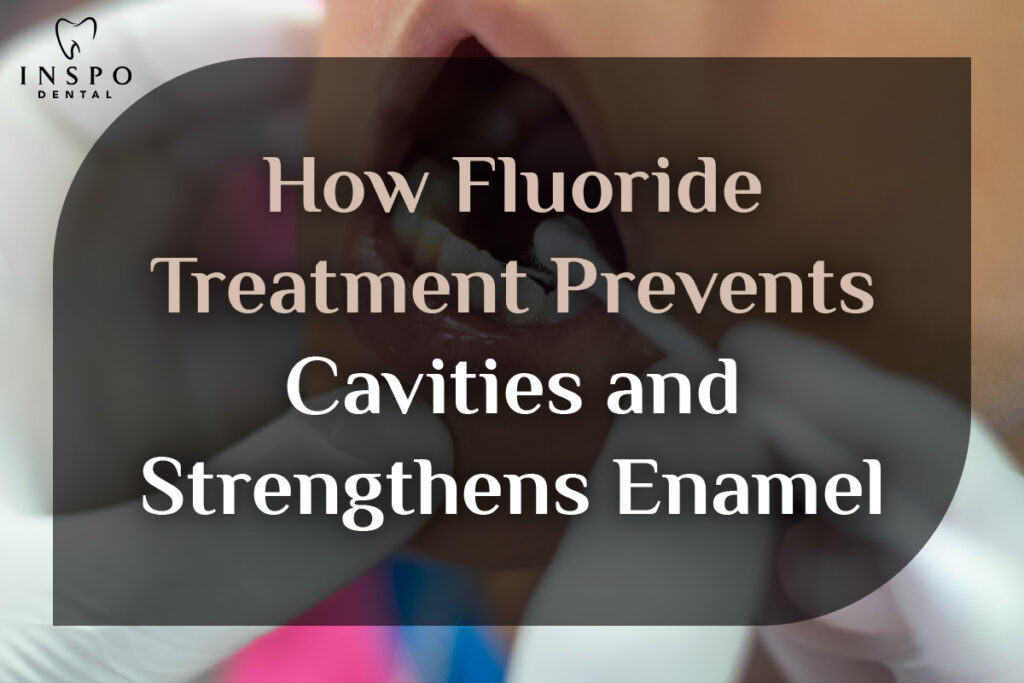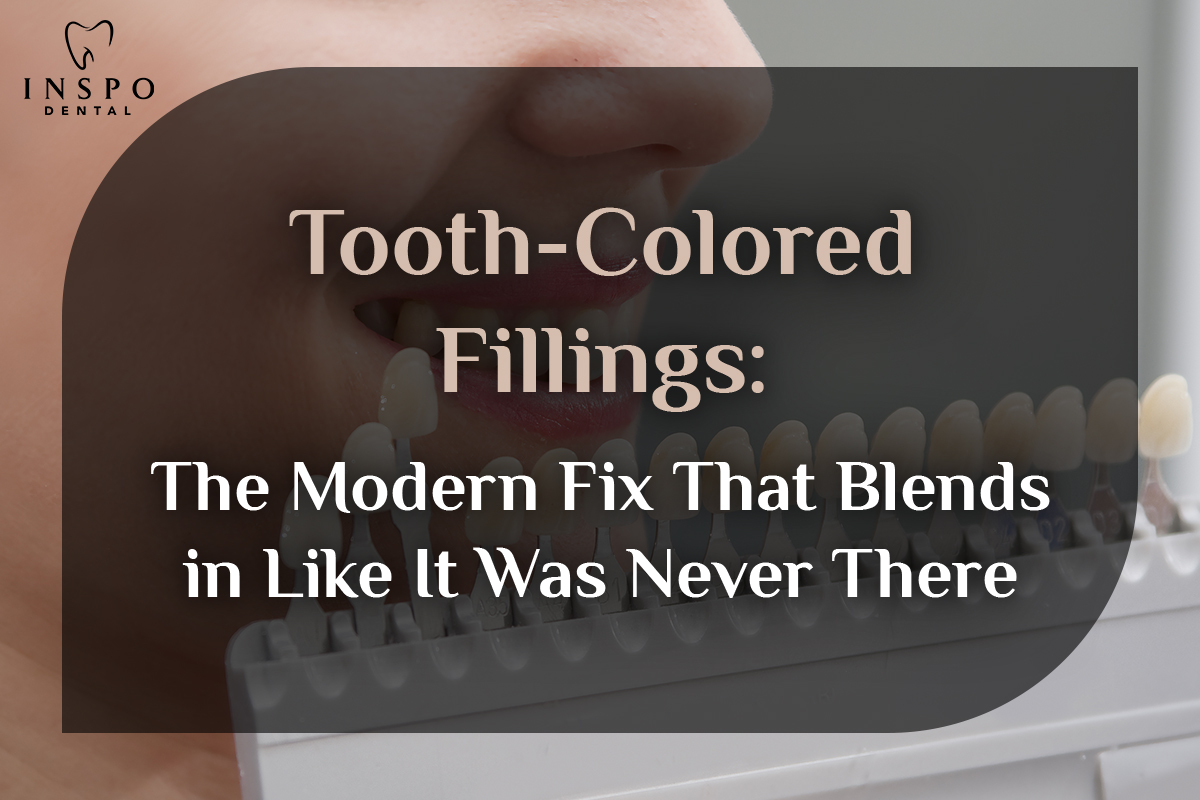🔍 Introduction: Why Fluoride Treatment Deserves Your Attention
In the realm of preventive dental care, fluoride treatment stands as one of the most effective, accessible, and scientifically backed interventions. While often associated with children, fluoride treatment is equally essential for adults seeking to protect their smile from decay and enamel erosion. This article breaks down how fluoride works, why it matters, and how it can transform your oral health long-term.
💡 What Is Fluoride and Why Is It Used in Dentistry?
Fluoride is a naturally occurring mineral found in water, soil, and certain foods. Its role in dentistry is nothing short of revolutionary. Since its introduction into dental care in the early 20th century, fluoride has helped millions of people avoid painful and costly dental issues.
Key Properties of Fluoride in Dentistry:
✅ Remineralizes weakened enamel
✅ Slows down the demineralization process
✅ Inhibits harmful bacteria in the mouth
✅ Promotes overall oral health
Dentists commonly apply concentrated fluoride through gels, varnishes, rinses, or foams during routine dental visits—especially for those at higher risk of decay.
🔐 How Fluoride Strengthens Tooth Enamel
Your enamel is the hard, outer layer of your teeth—and once it’s gone, it doesn’t regenerate. Here’s where fluoride treatment works its magic.
When acids from plaque bacteria and sugars attack the enamel, a process called demineralization begins. Fluoride combats this by initiating remineralization, a natural repair mechanism where minerals like calcium and phosphate are redeposited into the enamel layer.
The Science Behind It
Fluoride forms a compound called fluorapatite when it interacts with your teeth. This is a much stronger and more acid-resistant structure compared to the original enamel, making your teeth significantly more durable against everyday wear and bacterial attacks.
Result:
✅ Stronger enamel
✅ Reduced sensitivity
✅ Greater resistance to cavities
🛡️ How Fluoride Prevents Cavities Before They Start
Cavities don’t form overnight. They result from a long process of acid attacks on your teeth. Fluoride interrupts this cycle early on by:
✅ Neutralizing acids produced by bacteria
✅ Repairing early-stage decay (white spots)
✅ Blocking bacterial enzymes that cause cavities
✅ Forming a protective barrier on the tooth surface
This makes fluoride treatment a preventive powerhouse that not only protects but also actively heals micro-damage before it turns into something serious.
👶 Is Fluoride Treatment Safe for Children?
Absolutely. In fact, children benefit the most from fluoride during the early stages of tooth development.
Pediatric dentists recommend professional fluoride treatments starting from the age of 6 months to strengthen growing teeth and prevent early childhood caries (cavities in baby teeth).
Benefits of Fluoride for Children:
✅ Helps develop stronger permanent teeth
✅ Reduces the risk of early dental issues
✅ Encourages lifelong oral hygiene habits
However, it’s crucial to use age-appropriate fluoride dosages and supervise brushing to avoid ingestion, especially for toddlers.
👨⚕️ Do Adults Need Fluoride Treatments Too?
Many adults assume fluoride is only for kids—but that’s a myth. Adults can greatly benefit from fluoride, especially if they have:
✅ Receding gums
✅ Dry mouth (xerostomia)
✅ Frequent cavities
✅ Dental crowns or bridges
✅ Braces or orthodontic appliances
✅ A history of poor oral hygiene
Fluoride treatments in adults help reinforce vulnerable areas, reduce sensitivity, and keep dental work intact longer.
💧 Types of Fluoride Treatment Options Available
There are multiple ways to receive fluoride, depending on your needs and your dentist’s recommendation:
- Topical Fluoride
Topical treatments are applied directly to the teeth and include:
- Varnishes: Quick-drying and ideal for children.
- Gels or Foams: Usually applied via trays.
- Rinses: Recommended for home use in moderate cases.
- Toothpaste: Daily fluoride exposure from brushing.
- Systemic Fluoride
These include fluoridated water, fluoride supplements, or drops. These are typically recommended for children living in areas with low fluoride levels in water.
📊 Fluoride Varnish vs. Fluoride Gel: What’s the Difference?
Feature | Fluoride Varnish | Fluoride Gel |
Application Time | Quick (1–2 minutes) | 4 minutes |
Safety for Children | Very safe, low ingestion risk | Needs supervision |
Adhesion to Teeth | Sticks to tooth surface easily | Requires tray for application |
Frequency Recommended | Every 3–6 months | Every 6 months |
📌 How Often Should You Get Fluoride Treatment?
The frequency of fluoride treatments depends on your risk of dental caries and your age.
Low-Risk Patients:
✅ Once every 6–12 months
High-Risk Patients (frequent cavities, dry mouth, etc.):
✅ Every 3–6 months
Children:
✅ Typically every 3–6 months, based on pediatric guidelines
Your dentist will create a fluoride schedule customized to your oral health condition.
📉 What Happens If You Don’t Get Fluoride?
Skipping fluoride treatment can result in:
❌ Increased risk of enamel erosion
❌ Higher susceptibility to cavities
❌ Expensive restorative treatments later
❌ Chronic tooth sensitivity
❌ Early tooth loss in severe cases
By neglecting fluoride, you allow plaque acids to chip away at your enamel unchecked, leading to long-term oral health decline.
🧠 Common Myths About Fluoride—Debunked
Myth 1: Fluoride Is Dangerous
✅ Truth: When used appropriately, fluoride is completely safe and endorsed by the American Dental Association and WHO.
Myth 2: Natural Toothpaste Is Better
✅ Truth: Many natural toothpastes lack fluoride, which weakens their cavity-fighting potential.
Myth 3: Fluoride Is Only for Kids
✅ Truth: Adults with dental restorations, braces, or gum disease greatly benefit from fluoride.
Myth 4: Bottled Water Contains Fluoride
✅ Truth: Most bottled water doesn’t contain fluoride unless specified.
💬 What Patients Say About Fluoride Treatment
Many patients report:
✅ Less sensitivity after just one treatment
✅ A noticeable decrease in cavities over time
✅ Better oral checkups with fewer interventions
✅ Increased confidence in their dental hygiene
These testimonials reinforce fluoride’s importance not just as a clinical tool, but as a life-improving dental habit.
📦 At-Home Fluoride Solutions: Are They Enough?
While daily brushing with fluoride toothpaste is essential, it often isn’t enough for people prone to cavities.
Recommended At-Home Products:
✅ Fluoride toothpaste with 1000–1500 ppm
✅ Fluoride mouth rinses for added protection
✅ Prescription-strength gels for high-risk patients
Professional fluoride treatment offers a higher concentration than over-the-counter products, which is why it’s a crucial addition to your routine.
🧾 Is Fluoride Treatment Covered by Insurance?
Many dental insurance plans cover fluoride treatments for children up to a certain age. Some plans may also extend this to high-risk adults.
Before scheduling your appointment, it’s advisable to check:
✅ Your plan’s fluoride treatment frequency limit
✅ Whether adult fluoride treatment is included
✅ If a co-pay applies
Even without insurance, fluoride treatment is cost-effective, often ranging from $20 to $50—a small price for lasting oral health.
🧭 Tips to Maximize the Benefits of Fluoride Treatment
Here’s how to get the most out of your fluoride application:
✅ Avoid eating or drinking for at least 30 minutes after treatment
✅ Don’t brush or floss immediately after a varnish application
✅ Maintain your daily oral hygiene routine
✅ Ask your dentist about follow-up schedules
✅ Use a straw for acidic drinks to protect enamel
🧬 The Future of Fluoride: Innovations in Preventive Dentistry
Research is underway to develop smart fluoride technologies such as:
- Time-release fluoride varnishes
- Enamel-regenerating fluoride nanoparticles
- AI-based caries risk detection to customize fluoride use
These innovations will only reinforce the power of fluoride in maintaining healthier smiles across all age groups.
🏥 Fluoride Treatment During Routine Dental Visits: What to Expect
For those who’ve never had a professional fluoride application, the procedure is surprisingly quick and non-invasive—often completed in just a few minutes during a regular cleaning appointment.
Step-by-Step Process:
- Teeth Cleaning: Your hygienist will first remove any plaque and tartar buildup to ensure your teeth are clean and receptive.
- Fluoride Application: A high-concentration fluoride gel, foam, or varnish is applied using a brush, tray, or rinse.
- Absorption Time: You’ll be asked to avoid eating, drinking, or rinsing for 30 minutes to allow full absorption into the enamel.
- Post-Treatment Care: Dentists may provide tips to help maintain the fluoride’s effectiveness, such as using non-abrasive toothpaste.
This brief yet powerful treatment adds a critical layer of defense to your oral health arsenal—without discomfort, drilling, or recovery time.
🏠 Fluoride in Your Everyday Environment: Sources Beyond the Dentist
While professional fluoride treatments offer a concentrated boost, fluoride is also present in your environment. Being aware of these sources can help you maintain consistent fluoride exposure in a safe, balanced way.
Common Everyday Sources of Fluoride:
✅ Tap water (in fluoridated communities)
✅ Toothpaste and mouthwash
✅ Certain teas and seafood (naturally fluoride-rich)
✅ Teflon-coated cookware (minimal levels, but present)
Monitoring these sources helps ensure you’re not under- or over-consuming fluoride. Your dental provider can help assess your daily fluoride exposure and recommend whether supplemental treatment is necessary.
⚖️ The Right Balance: Avoiding Fluorosis
While fluoride is beneficial, too much of it—particularly during early childhood—can lead to dental fluorosis, a condition that affects the appearance of tooth enamel. It’s typically characterized by faint white spots or streaks.
How to Prevent Fluorosis:
✅ Supervise brushing for children under 6
✅ Use a pea-sized amount of fluoride toothpaste
✅ Store toothpaste and supplements out of reach of young children
✅ Use fluoride supplements only under professional supervision
Fluorosis is largely cosmetic and does not impact tooth function, but it’s best avoided through mindful use and proper guidance.
🧪 Scientific Research Supporting Fluoride Treatment
A wealth of scientific literature supports fluoride’s efficacy in reducing cavities and strengthening enamel. In fact, the Centers for Disease Control and Prevention (CDC) has recognized water fluoridation as one of the top public health achievements of the 20th century.
Notable Findings:
- A 2018 Cochrane review found that professional fluoride varnish can reduce cavity risk by 43% in permanent teeth.
- Studies show that communities with fluoridated water see up to 25% fewer cavities in both children and adults.
- Dental schools and regulatory bodies globally recommend fluoride as a first-line defense against caries.
This body of evidence confirms that fluoride isn’t a marketing gimmick—it’s a clinical necessity backed by decades of rigorous research.
🏆 Fluoride as Part of a Complete Oral Care Strategy
While fluoride is a powerful agent, it works best in conjunction with a comprehensive oral care routine. Think of it as your defense line—strong, but more effective when combined with good hygiene and lifestyle habits.
Best Practices to Pair with Fluoride:
✅ Brush twice daily with fluoride toothpaste
✅ Floss at least once a day to remove hidden debris
✅ Avoid sugary snacks and drinks between meals
✅ Rinse after acidic foods (e.g., citrus, soda)
✅ Visit your dentist every 6 months for checkups
By building a multi-layered approach, you amplify fluoride’s benefits and dramatically reduce your risk of dental issues.
🧭 Who Should Avoid Fluoride Treatments?
While fluoride is safe for the vast majority of people, there are certain individuals who may need alternative approaches or dosage adjustments.
Situations Where Caution Is Needed:
- People with fluoride allergies (very rare, but possible)
- Patients with kidney disease, where fluoride retention may be a concern
- Infants under 6 months, who typically don’t require fluoride unless medically advised
- Residents in areas with excessive natural fluoride levels in groundwater
In such cases, a dentist or medical professional can provide personalized recommendations based on risk levels and oral health needs.
🛒 Choosing the Right Fluoride Products at Home
The dental aisle is full of products claiming to boost enamel and prevent cavities—but not all fluoride products are created equal. Understanding how to choose the right fluoride-based items can make a significant difference.
What to Look for:
✅ Look for ADA Seal of Acceptance
✅ Check fluoride concentration:
- 1000–1500 ppm in toothpaste
- 0.05% sodium fluoride in daily rinses
✅ Avoid whitening pastes if you have sensitivity issues
✅ Prefer alcohol-free rinses for dry mouth sufferers
✅ Ask your dentist about prescription-strength pastes for high-risk teeth
Making informed choices ensures you’re reinforcing your teeth with the right amount of fluoride, tailored to your individual needs.
🌱 Fluoride and Natural Dentistry: Is There a Middle Ground?
With the rise of natural health trends, some patients question the use of fluoride and seek fluoride-free options. While that’s a personal choice, it’s important to understand the evidence-based role fluoride plays.
A Balanced Approach:
- You can opt for natural fluoride sources such as black tea and spring water rich in minerals.
- Use fluoride toothpaste in rotation with herbal alternatives.
- Choose organic brands that include naturally sourced fluoride or remineralizing agents like hydroxyapatite.
Always speak with your dentist before abandoning fluoride entirely, especially if you have a history of dental issues. The goal is to strike a balance between natural wellness and proven prevention.
📚 Educating Families: Teaching Fluoride Importance at Home
Many parents struggle to explain why fluoride matters—especially to children. Making fluoride fun and relatable can increase cooperation and establish lifelong oral care habits.
Tips to Teach Kids About Fluoride:
✅ Use colorful educational videos or storybooks
✅ Create a reward chart for fluoride brushing
✅ Let kids pick their own fluoride toothpaste flavors
✅ Do brushing time as a family activity
✅ Schedule dentist visits as “superhero checkups”
When children understand why they’re using fluoride, they’re more likely to embrace it—not just now, but for life.
🔄 Fluoride and Its Role in Reversing Early Decay
One of fluoride’s most underappreciated benefits is its ability to reverse early tooth decay—a concept that may surprise many.
How it Works:
When tooth enamel begins to demineralize, it appears as white spots—a reversible stage of decay. Fluoride promotes the return of minerals to these areas, effectively stopping cavities before they form.
This ability to heal before drilling is what makes fluoride a cornerstone of modern, conservative dentistry—emphasizing preservation over intervention.
🧱 Building Long-Term Oral Resilience with Fluoride
Dental health isn’t a one-time fix—it’s a long-term investment. Fluoride strengthens the foundation of your teeth in a way that protects you now and as you age.
Lifelong Benefits:
✅ Reduces dental expenses over a lifetime
✅ Lowers your risk for gum disease and root decay
✅ Supports better breath and fresher smile
✅ Helps retain natural teeth into old age
The small habit of fluoride use now can pay off for decades—literally adding years to the health and functionality of your teeth.
🌍 Fluoride Around the World: A Global Perspective
While fluoride has become a standard part of dental care in many countries, its application and accessibility vary widely across the globe. Understanding how different regions approach fluoride use helps paint a clearer picture of its impact on public oral health.
Global Approaches to Fluoridation:
- United States & Canada: Widespread water fluoridation has led to significant reductions in tooth decay across all age groups.
- Australia & New Zealand: Fluoride is added to water and actively promoted through public health initiatives.
- European Union: Many countries do not fluoridate water but rely heavily on fluoride toothpaste and varnishes.
- India: Fluoride in water varies by region; some areas naturally have higher fluoride levels, while others rely on dental products for supplementation.
- Africa & Southeast Asia: Access remains inconsistent; fluoride deficiency continues to contribute to high rates of tooth decay, especially in rural areas.
The global consensus remains clear—fluoride is one of the most cost-effective and scalable solutions to reduce dental disease worldwide, especially in underserved populations.
🔬 Beyond Cavities: Fluoride’s Role in Managing Tooth Sensitivity
Though fluoride is best known for preventing cavities, it also serves a critical function in reducing tooth sensitivity, particularly in adults and seniors.
Tooth sensitivity occurs when the protective enamel wears away or gums recede, exposing the dentin layer beneath, which contains microscopic tubules that connect directly to the nerve.
How Fluoride Helps with Sensitivity:
✅ It seals open dentin tubules, reducing transmission to the nerve
✅ It remineralizes areas of demineralized enamel, restoring protection
✅ It forms a barrier against hot, cold, or sweet stimuli
Fluoride varnishes are especially effective when applied directly to sensitive areas. Many dentists recommend these for patients post-whitening treatments, after gum recession, or if daily discomfort affects quality of life.
🧱 Building Fluoride into Lifestyle, Not Just Treatment
While professional fluoride treatments are vital, long-term success comes from integrating fluoride into everyday habits. Think of it as micro-protection, daily delivered.
Daily Fluoride Habits That Matter:
✅ Brushing with fluoride toothpaste twice a day
✅ Using a fluoride mouth rinse before bed
✅ Avoiding constant snacking to give enamel time to heal
✅ Rinsing after consuming acidic foods (fruit, soda, wine)
✅ Drinking fluoridated tap water when available
When combined, these habits form an ecosystem of enamel defense, reinforcing the work done during professional dental visits.
🔍 Fluoride and Orthodontics: A Must-Have Protection
For patients with braces or other orthodontic appliances, maintaining oral hygiene becomes more challenging—and the risk of cavities increases significantly due to food traps and limited brush access.
This makes fluoride treatments particularly critical for orthodontic patients.
Why Orthodontic Patients Need Fluoride:
✅ Brackets and wires trap plaque easily
✅ Enamel decalcification (white spots) is common
✅ Increased risk of interproximal cavities
✅ Limited flossing makes fluoride even more valuable
Orthodontists often prescribe high-fluoride toothpaste or gels and may recommend more frequent in-office fluoride applications during the course of treatment.
📝 Conclusion: Invest in Your Smile with Fluoride
If you’re serious about keeping your teeth healthy, strong, and cavity-free for life, fluoride treatment is non-negotiable. It’s one of the most affordable, painless, and scientifically proven dental procedures available today.
Whether you’re a parent safeguarding your child’s smile or an adult aiming to preserve your dental work, fluoride offers the shield your enamel needs against everyday decay.
📞 Schedule Your Fluoride Treatment Today
Don’t wait until cavities form—act proactively.
Speak with your dentist about a personalized fluoride treatment plan and experience the difference strong enamel makes.
✅ Strengthen enamel
✅ Prevent cavities
✅ Protect your smile—long term






